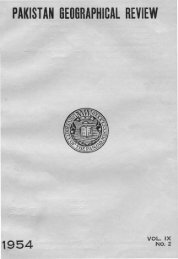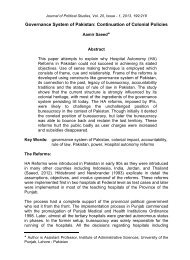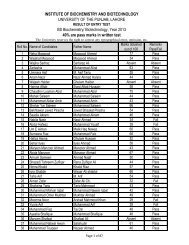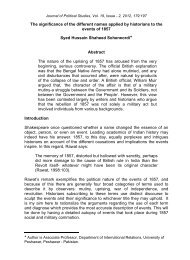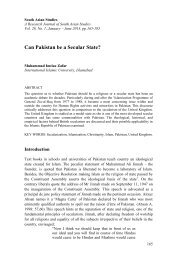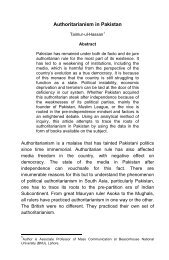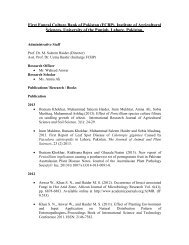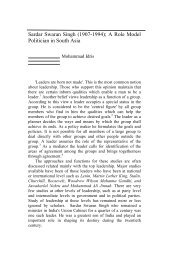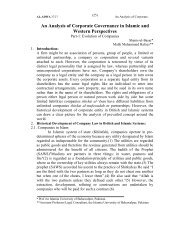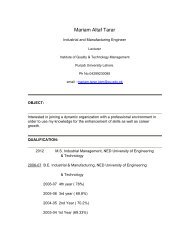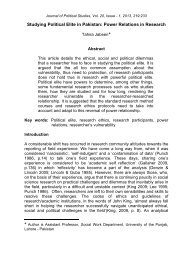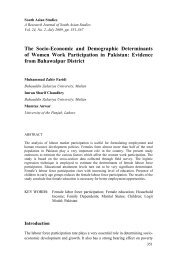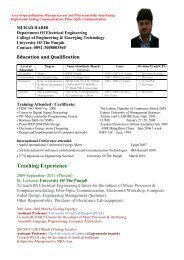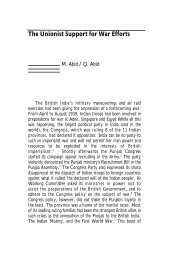Reconceptualising Domestic Violence as 'Domestic Torture'
Reconceptualising Domestic Violence as 'Domestic Torture'
Reconceptualising Domestic Violence as 'Domestic Torture'
You also want an ePaper? Increase the reach of your titles
YUMPU automatically turns print PDFs into web optimized ePapers that Google loves.
Shazia Qureshi<br />
However, some experts vehemently oppose the idea that pain suffered in the<br />
private sphere, without the participation of state officials, might be seen <strong>as</strong><br />
torture (Grdinic, 1999-2000: 218). Edward argues that ‘torture is torment<br />
inflicted by a public authority, for ostensibly public purpose’ (Peters,1999: 3)<br />
and attempts to eliminate state involvement element might dilute the impact of<br />
the current understanding of the torture concept (Meyerfeld,2003-04: 401). He<br />
refers to the idea of redefining acute forms of domestic violence in terms of<br />
HRL violations, among the ‘sentimental uses’ of the word torture (Peters,1999:<br />
2-3, 9, 150, 153).<br />
Yet feminists’ efforts/demands stimulated some level of developments in this<br />
area of HRL. Amnesty International (AI) VAW made a gendered intervention in<br />
the debate on torture through its 2001 report (Youngs, 2003: 1215). It also<br />
initiated a global campaign against VAW during that time.<br />
Recognizing the structural forms of VAW the AI report considers that:<br />
The acts of violence against women in the home or the<br />
community constitute torture for which the state is accountable<br />
when they are of the nature and severity envisaged by the<br />
concept of torture in international standards and the state h<strong>as</strong><br />
failed to fulfill its obligation to provide effective protection.<br />
The inclusion of gender in the understanding of torture by the most acclaimed<br />
mainstream human rights advocacy group w<strong>as</strong> particularly an important step<br />
forward. In this report AI attempted to reconcile the provisions of CAT with the<br />
advances made by other UN bodies that have integrated gender analysis in<br />
their monitoring and reporting of human rights violations against women<br />
(Youngs, 2003: 1216). In 2008, the Special Rapporteur on torture and other,<br />
inhuman or degrading treatment or punishment, reported on strengthening the<br />
protection of women from torture and a gender sensitive interpretation of<br />
torture (http://www.violenceisnotourculture.org/resources/%E2%80%9C<br />
strengthening-protection-women-torture-and-ill-treatment%E2%80%9Dstatement-manfred-nowak).<br />
He found significant commonalities between<br />
torture that occurs in public and private realm in terms of strategies, process<br />
and consequent trauma (http://www.violenceisnotourculture.org/sites/<br />
default/files/UN%20Special%20Rapporteur%20Torture%20Report%<br />
202008.pdf). He suggested insertion of the concept of ‘powerlessness’ in the<br />
CAT’s definition of torture, which according to him lies at the heart of victimabuser<br />
relationship. This approach suggests the exercise of effective/coercive<br />
control of one person over another, <strong>as</strong> the criterion for determination of<br />
torture, regardless of whether it takes place in official context or otherwise.<br />
The powerlessness test when applied in the domestic violence context, would<br />
determine the power of victim in a given situation. If a victim, given her<br />
42



